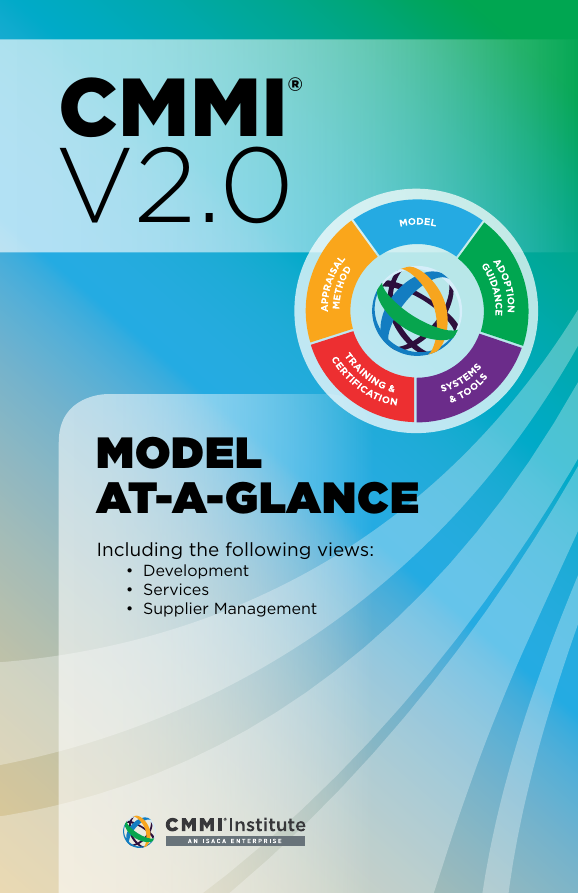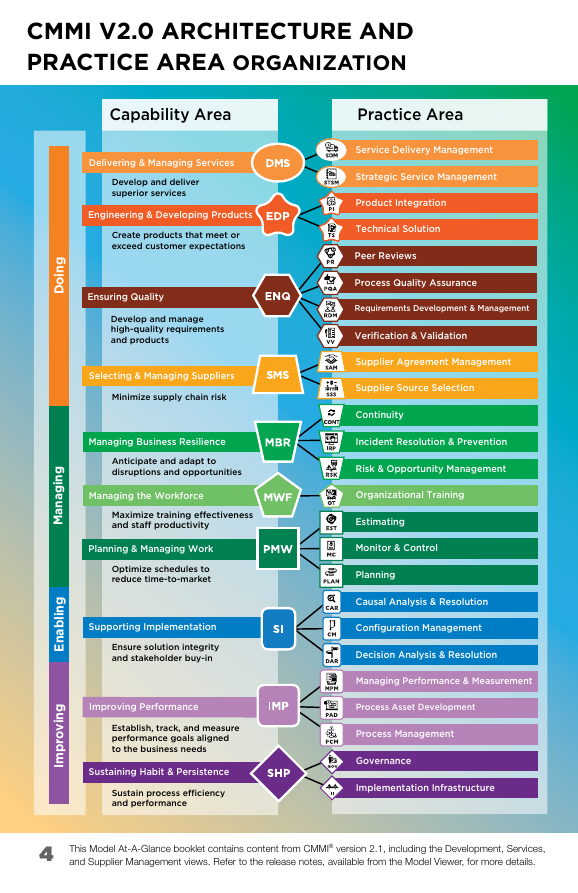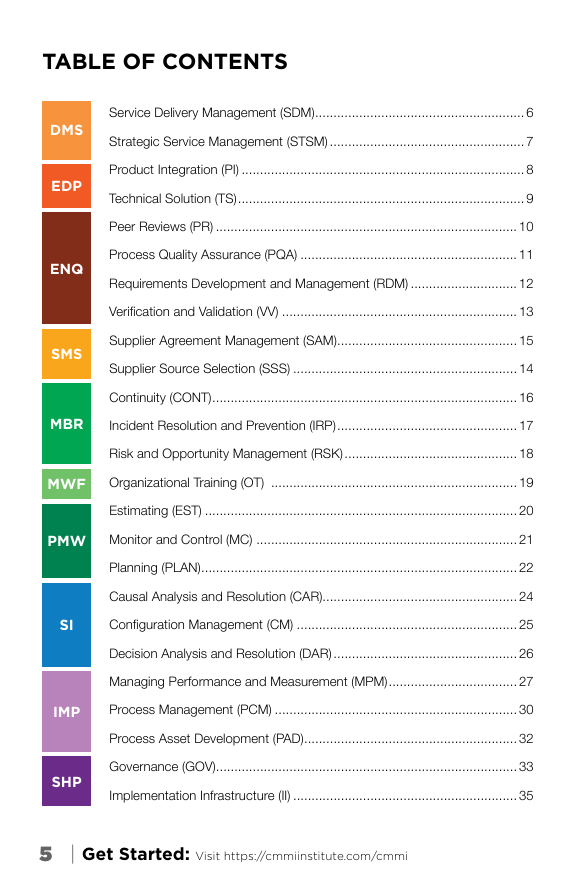CMMI®
V2.0
ModeL
at-a-gLance
Including the following views:
• Development
• Services
• Supplier Management
�
cMMI ®
V2.0
an Integrated
Product Suite
Designed to meet the challenges
of the changing global business
landscape, the CMMI model and integrated
product suite help organizations drive business performance
through building and benchmarking key capabilities.
MODEL
• Clear pathway to performance improvement
• Simplified for accelerated adoption
APPRAISAL METHOD
• New appraisal method to increase reliability and reduce cost
TRAINING &
CERTIFICATION
Updated training includes:
• Modular training components
• A focus on learner objectives
• Virtual and in-person options
SYSTEMS & TOOLS
• Redesigned system to access online models and resources
ADOPTION GUIDANCE
• Guidance for new adopters to get started with CMMI
• Guidance for transition from CMMI V1.3 to CMMI V2.0
�
What is the
cMMI V2.0 Model?
The Capability Maturity Model Integration (CMMI)® is a proven
set of global best practices that drives business performance
through building and benchmarking key capabilities.
CMMI best practices focus on what needs to be done to
improve performance and align operations to business goals.
Designed to be understandable, accessible, flexible, and
integrate with other methodologies such as agile, CMMI helps
organizations understand their current level of capability and
performance and offers a guide to optimize business results.
CMMI V2.0 is one model with multiple customized views
that apply to different business environments, enabling
organizations to create a view of the model that meets their
specific performance improvement needs.
cMMI V2.0
Model at-a-glance
The Model At-A-Glance booklet includes a summary of CMMI
Capability Areas, Practice Areas, and practices.
This summary will provide a helpful overview of the model
content areas, but users should read and refer to the complete
model content to ensure full understanding and accurate
interpretation of the model.
The CMMI model is available for purchase at:
https://cmmiinstitute.com/model-viewer
�
CMMI V2.0 ArChIteCture And
PrACtICe AreA OrgAnIzAtIOn
Capability Area
Practice Area
Delivering & Managing Services
Develop and deliver
superior services
Engineering & Developing Products
Create products that meet or
exceed customer expectations
Ensuring Quality
Develop and manage
high-quality requirements
and products
Selecting & Managing Suppliers
Minimize supply chain risk
Service Delivery Management
Strategic Service Management
Product Integration
Technical Solution
Peer Reviews
Process Quality Assurance
Requirements Development & Management
Verification & Validation
Supplier Agreement Management
Supplier Source Selection
Continuity
Managing Business Resilience
Incident Resolution & Prevention
Anticipate and adapt to
disruptions and opportunities
Risk & Opportunity Management
Managing the Workforce
Organizational Training
Maximize training e†ectiveness
and sta† productivity
Planning & Managing Work
Optimize schedules to
reduce time-to-market
Supporting Implementation
Ensure solution integrity
and stakeholder buy-in
Estimating
Monitor & Control
Planning
Causal Analysis & Resolution
Configuration Management
Decision Analysis & Resolution
Managing Performance & Measurement
Improving Performance
Process Asset Development
Establish, track, and measure
performance goals aligned
to the business needs
Sustaining Habit & Persistence
Sustain process e‰ciency
and performance
Process Management
Governance
Implementation Infrastructure
i
g
n
o
D
i
g
n
g
a
n
a
M
g
n
i
l
b
a
n
E
g
n
i
v
o
r
p
m
I
4
This Model At-A-Glance booklet contains content from CMMI® version 2.1, including the Development, Services,
and Supplier Management views. Refer to the release notes, available from the Model Viewer, for more details.
�
tAble Of COntentS
dMS
edP
enQ
SMS
Mbr
MWf
PMW
SI
IMP
ShP
Service Delivery Management (SDM) .........................................................6
Strategic Service Management (STSM) .....................................................7
Product Integration (PI) .............................................................................8
Technical Solution (TS) ..............................................................................9
Peer Reviews (PR) ..................................................................................10
Process Quality Assurance (PQA) ...........................................................11
Requirements Development and Management (RDM) .............................12
Verification and Validation (VV) ................................................................13
Supplier Agreement Management (SAM) .................................................15
Supplier Source Selection (SSS) .............................................................14
Continuity (ConT) ...................................................................................16
Incident Resolution and Prevention (IRP) .................................................17
Risk and opportunity Management (RSk) ...............................................18
organizational Training (oT) ...................................................................19
Estimating (EST) .....................................................................................20
Monitor and Control (MC) .......................................................................21
Planning (PlAn) ......................................................................................22
Causal Analysis and Resolution (CAR)..................................................... 24
Configuration Management (CM) ............................................................25
Decision Analysis and Resolution (DAR) ..................................................26
Managing Performance and Measurement (MPM) ...................................27
Process Management (PCM) ..................................................................30
Process Asset Development (PAD) ..........................................................32
Governance (GoV) ..................................................................................33
Implementation Infrastructure (II) .............................................................35
5
| get Started: Visit https://cmmiinstitute.com/cmmi
�
SerVICe delIVery
MAnAgeMent
Intent
Deliver services and manage the service delivery system.
Value
Increase customer satisfaction by delivering services that meet or exceed
customer expectations.
Additional required PA Information
This includes:
• Delivering services in accordance with service delivery
approaches and agreements
• Managing changes to the service delivery system
• Receiving and processing service requests
• Maintaining service delivery performance when changes occur
Practice Summary
SDM 1.1
Use the service system to deliver services.
SDM 2.1
SDM 2.2
SDM 2.3
SDM 2.4
SDM 2.5
SDM 2.6
SDM 3.1
Develop, record, keep updated, and follow
service agreements.
Receive and process service requests in
accordance with service agreements.
Deliver services in accordance with service
agreements.
Analyze existing service agreements and
service data to prepare for updated or new
agreements.
Develop, record, keep updated, and follow
the approach for operating and changing
the service system.
Confirm the readiness of the service system
to support the delivery of services.
Develop, record, keep updated, and use
organizational standard service systems
and agreements.
1
2
3
6
I
I
S
e
C
V
r
e
S
g
n
g
A
n
A
M
&
g
n
r
e
V
I
l
e
d
I
| Get Started: Visit https://cmmiinstitute.com/cmmi �
StrAtegIC SerVICe
MAnAgeMent
Intent
Develop and deploy standard services that are compatible with
strategic business needs and plans.
Value
Increases likelihood of meeting business objectives by aligning
standard services with customer needs.
Practice Summary
1
Develop a list of current services.
STSM 1.1
2
STSM 2.1
STSM 2.2
STSM 2.3
Develop, keep updated, and use
descriptions of current services.
Collect, record, and analyze data about
strategic needs and capabilities for service
delivery.
Develop, keep updated, and follow an
approach for providing new or changed
services derived from strategic needs and
capabilities.
3
STSM 3.1
Develop, keep updated, and use the set
of organizational standard services and
service levels.
7
I
I
S
e
C
V
r
e
S
g
n
g
A
n
A
M
&
g
n
r
e
V
I
l
e
d
I
| Get Started: Visit https://cmmiinstitute.com/cmmi �
IntegrAtIOn
PrOduCt
Intent
Integrate and deliver the solution that addresses functionality and quality
requirements.
Value
Increases customers’ satisfaction by giving them a solution that meets or
exceeds their functionality and quality requirements.
Practice Summary
1
Assemble solutions and deliver to the customer.
PI 1.1
PI 2.1
PI 2.2
PI 2.3
PI 2.4
PI 2.5
PI 2.6
PI 3.1
PI 3.2
PI 3.3
Develop, keep updated, and follow an
integration strategy.
Develop, keep updated, and use the integration
environment.
Develop, keep updated, and follow procedures
and criteria for integrating solutions and
components.
Confirm, prior to integration, that each
component has been properly identified and
operates according to its requirements
and design.
Evaluate integrated components to ensure
conformance to the solution’s requirements and
design.
Integrate solutions and components according
to the integration strategy.
Review and keep updated interface or
connection descriptions for coverage,
completeness, and consistency throughout the
solution’s life.
Confirm, prior to integration, that component
interfaces or connections comply with interface
or connection descriptions.
Evaluate integrated components for interface or
connection compatibility.
2
3
8
S
t
C
u
d
O
r
P
g
n
I
P
O
l
e
V
e
d
&
g
n
r
e
e
n
g
n
e
I
I
| Get Started: Visit https://cmmiinstitute.com/cmmi �
















 2023年江西萍乡中考道德与法治真题及答案.doc
2023年江西萍乡中考道德与法治真题及答案.doc 2012年重庆南川中考生物真题及答案.doc
2012年重庆南川中考生物真题及答案.doc 2013年江西师范大学地理学综合及文艺理论基础考研真题.doc
2013年江西师范大学地理学综合及文艺理论基础考研真题.doc 2020年四川甘孜小升初语文真题及答案I卷.doc
2020年四川甘孜小升初语文真题及答案I卷.doc 2020年注册岩土工程师专业基础考试真题及答案.doc
2020年注册岩土工程师专业基础考试真题及答案.doc 2023-2024学年福建省厦门市九年级上学期数学月考试题及答案.doc
2023-2024学年福建省厦门市九年级上学期数学月考试题及答案.doc 2021-2022学年辽宁省沈阳市大东区九年级上学期语文期末试题及答案.doc
2021-2022学年辽宁省沈阳市大东区九年级上学期语文期末试题及答案.doc 2022-2023学年北京东城区初三第一学期物理期末试卷及答案.doc
2022-2023学年北京东城区初三第一学期物理期末试卷及答案.doc 2018上半年江西教师资格初中地理学科知识与教学能力真题及答案.doc
2018上半年江西教师资格初中地理学科知识与教学能力真题及答案.doc 2012年河北国家公务员申论考试真题及答案-省级.doc
2012年河北国家公务员申论考试真题及答案-省级.doc 2020-2021学年江苏省扬州市江都区邵樊片九年级上学期数学第一次质量检测试题及答案.doc
2020-2021学年江苏省扬州市江都区邵樊片九年级上学期数学第一次质量检测试题及答案.doc 2022下半年黑龙江教师资格证中学综合素质真题及答案.doc
2022下半年黑龙江教师资格证中学综合素质真题及答案.doc